|
Fill
'Er Up
by
Bob Brooke
Remember the days when your dad pulled
the family car into a gas station and a friendly young man would come
out and ask you how much gas you wanted? And while the gas gurgled into
the tank, he would clean the car’s windshield and lift the hood to check
the oil, wiping the dipstick with a rag hs pulled from the back pocket
of his overalls. Those were the days.
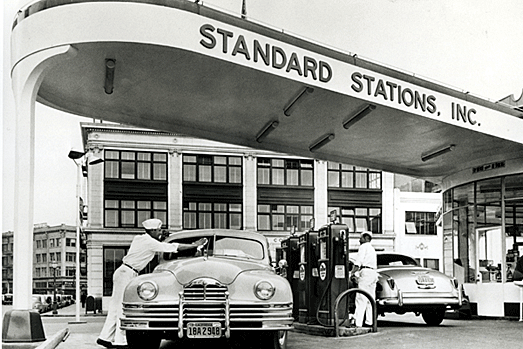
And those memories are what drive petroliana collectors, that is
collectors of gas station equipment and memorabilia.
The passion petroliana collectors have for vintage gas pumps and the
globes that adorned them certainly proves one man's trash is another
man's treasure, since the quest for such relics often leads them to city
dumps and farm pastures. When found, most of the castoffs are rusty
shadows of their former selves, yet there are many willing to spend a
small fortune to resurrect what they consider coveted items.
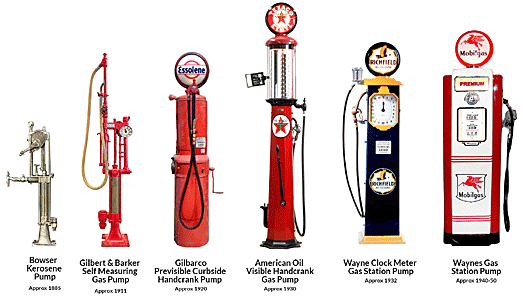
The Search for the Elusive Glass Globe
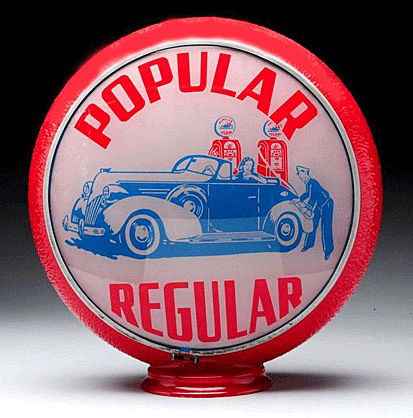 Relentless
in their search for globes, collectors seek names like Richfield,
Magnolia Petroleum, Veltex, Husky. Kendall, Fire Chief, Lion, Signal and
Red Crown. Sentimentality drives the petroliana market because it's
difficult for a collector to see an old globe and not want to own it,
particularly if he—the majority of petroliana collectors are men—already
owns a previsible or visible gas pump or the more familiar clock-face
pump. Relentless
in their search for globes, collectors seek names like Richfield,
Magnolia Petroleum, Veltex, Husky. Kendall, Fire Chief, Lion, Signal and
Red Crown. Sentimentality drives the petroliana market because it's
difficult for a collector to see an old globe and not want to own it,
particularly if he—the majority of petroliana collectors are men—already
owns a previsible or visible gas pump or the more familiar clock-face
pump.
In its heyday "global" lighting was perhaps the best advertising idea
ever conceived by gasoline companies. For years, they elevated globes of
different sizes and shapes to the tops of gas pumps, yet these had
nothing to do with moving the gas into the automobile. It was merely an
artistic way to identify various petroleum companies.
Prior to the automobile in the early 20th century, people used kerosene
and gasoline for lighting. They purchased these fuels at general stores,
which kept them inside or outside of the building. The storekeeper
hand-dispensed the desired amount into a measuring container, then
carried it to the automobile where he would pour it through a funnel
into the gas tank.
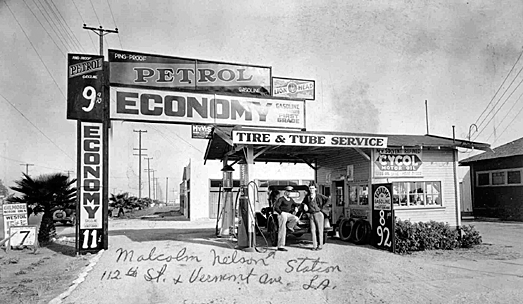
In the late 1880s, Sylvanus F. Bowser of Fort Wayne, Indiana, invented a
method to pump kerosene, and later gasoline, from one container to
another. By the turn of the 20th century, he had developed the first
outdoor pump to dispense gasoline. Since then, gas pumps have undergone
at least five major design transformations affecting size, appearance,
capacity, material and internal mechanisms.
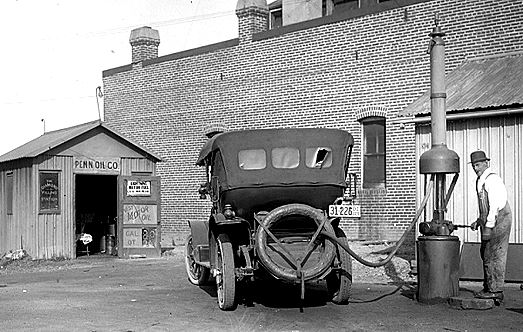
Once the dangers of above-ground storage became known and the pump
theory became reality, John J. Tokheim of Cedar Rapids, Iowa, took the
process a step further by introducing an underground receptacle to hold
the gasoline. In 1901, Tokheim patented a pump that could measure the
amount and price of fuel taken from it.
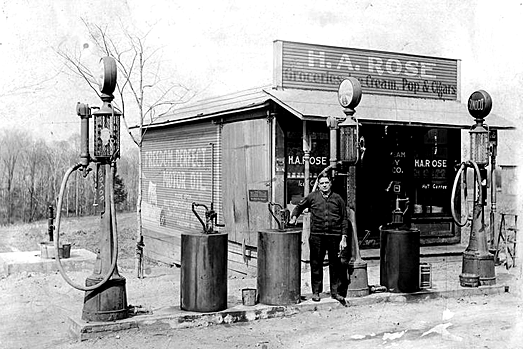
Its logical placement was "curbside," where a driver
could pull up to a permanent hand-operated pump located above ground
with a hose connected to it, allowing the fuel to flow into the car.
Beginning in 1907 and for the next 13 years, the curbsides, called “previsibles,”
soon dotted American streets. Though they weren’t large, and while they
solved one problem, they created a couple of others.
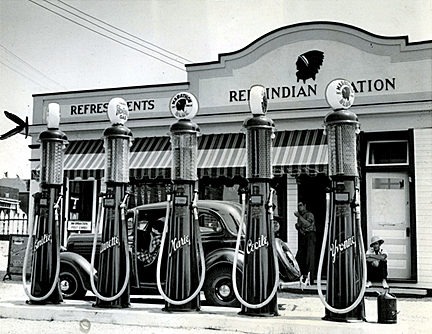 To
accurately measure the amount of gasoline sold, early manufacturers put
“ stops” on the pump, usually in small increments, allowing the
purchaser to regulate the amount he wanted. Unfortunately, the
popularity of doing curbside business often created "traffic
congestions," forcing city officials to place limits on the number of
pumps installed within each municipality. To
accurately measure the amount of gasoline sold, early manufacturers put
“ stops” on the pump, usually in small increments, allowing the
purchaser to regulate the amount he wanted. Unfortunately, the
popularity of doing curbside business often created "traffic
congestions," forcing city officials to place limits on the number of
pumps installed within each municipality.
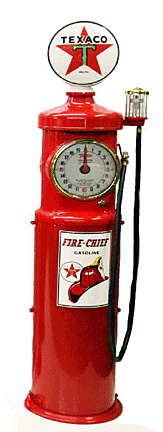 The
"visible" pump came along in the 1920s, along with the concept of a
"filling station," an off-street building with the sole purpose of
selling only gasoline. A visible pump serves a dual purpose. The tall
glass cylinder on top of the gas dispenser allowed the customer to see
both the fuel and the amount being pumped into the car. The
"visible" pump came along in the 1920s, along with the concept of a
"filling station," an off-street building with the sole purpose of
selling only gasoline. A visible pump serves a dual purpose. The tall
glass cylinder on top of the gas dispenser allowed the customer to see
both the fuel and the amount being pumped into the car.
Though many companies produced this type of visible pump until about
1925, the best-known manufacturers were Bowser, Tokheim, the Wayne Pump
Company of Fort Wayne, Indiana, and Bair Pump Company of Adrian,
Michigan.
The "clock-face" pump appeared in the late 1920s, using meter and dials
to indicate the number of gallons sold. A "visi-gauge" was sometimes
placed on the side, allowing the customer to watch how much fuel went
into his car. Until the computer pump came along, often a printed card
showing increment prices per gallon and the tax rate also would be
attached to the sides of the pumps.
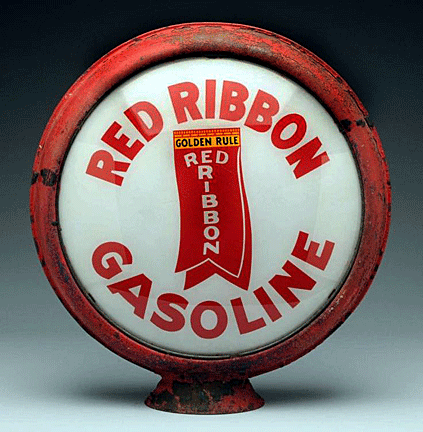 The
globes accompanying those early pumps fall into four categories. The
first style used from 1900 to the early 1920s, was a one-piece glass
model, very generic with no lens, advertising "gasoline" or "filtered
gasoline." Most were made of milk glass rather than clear glass. The
globes accompanying those early pumps fall into four categories. The
first style used from 1900 to the early 1920s, was a one-piece glass
model, very generic with no lens, advertising "gasoline" or "filtered
gasoline." Most were made of milk glass rather than clear glass.
Next came the metal frame globes, used from 1925 to 1932, with a glass
lens, followed by the glass body with glass inserts, used from the late
1920s through the early 1960s, but more prevalent in the mid-1930s and
'40s, and finally, the plastic bodies with glass inserts. Although some
of these were produced in the 1930s, they were more commonly seen during
the 1950s.
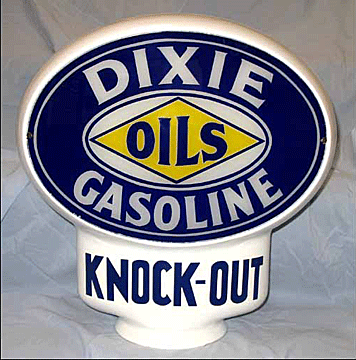 Manufacturers
etched, painted, raised, baked, or cast oil company names onto the
globe. Body styles and size could be quite different from the usual
round and smooth globe. One example was called a "ripple" because of its
outside texture. Produced by the Gill Glass Company of Pennsylvania, it
reminded some of snake skin. The Hull Glass Company, also of
Pennsylvania, made another style that featured a concave body center. Manufacturers
etched, painted, raised, baked, or cast oil company names onto the
globe. Body styles and size could be quite different from the usual
round and smooth globe. One example was called a "ripple" because of its
outside texture. Produced by the Gill Glass Company of Pennsylvania, it
reminded some of snake skin. The Hull Glass Company, also of
Pennsylvania, made another style that featured a concave body center.
Vintage pumps and globes range from several hundred to several thousands
of dollars, depending on whether it is original, restored or a
reproduction. Condition, rarity, design and in the case of globes, the
company logo, are very important.
The oil companies recognized the popularity of these early pumps, and it
wasn't long before they required filling stations to own them. Of
course, this included the specialized advertising of each company whose
names perched on the domes of individual receptacles.
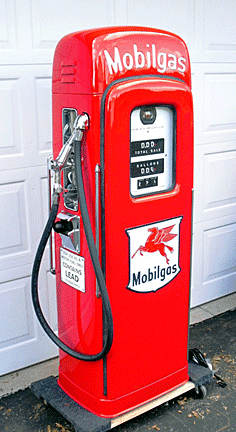 Most
collectors want what they grew up with—a reminder of their hometown
service station where they first worked, their first car or a certain
brand of gasoline they first used. Since it is almost impossible to find
an original pump or globe that doesn't need a "facelift," collectors are
always on the lookout for topnotch restorers and sources for replacement
parts. Most
collectors want what they grew up with—a reminder of their hometown
service station where they first worked, their first car or a certain
brand of gasoline they first used. Since it is almost impossible to find
an original pump or globe that doesn't need a "facelift," collectors are
always on the lookout for topnotch restorers and sources for replacement
parts.
While the older, original pumps and globes may be vanishing, they can
still be found at swap meets, flea markets, antique malls or antique
shows. There are also numerous collector organizations and sources such
as the Internet, and classified ads in local newspapers that could prove
helpful. Those who can't afford this older memorabilia have turned to
the multitude of accessories 'that are available. Remember, what is used
today will be collectible tomorrow.
The Birth of the Service Station
In the 1930s, filling stations became "service stations," branching out
to help customers with additional services such as lubrication, tire
repair, oil changes, etc. A variety of interesting items, which are now
available to petroliana collectors, came into use.
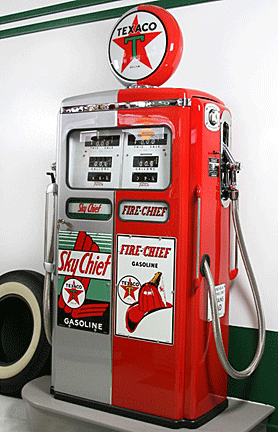 Petroliana
buffs may choose from many interesting cabinetry designs produced from
the 1930s through the beginning of World War II. While the giant oil
companies survived the Great Depression, they didn’t develop any new
designs for their stations. Petroliana
buffs may choose from many interesting cabinetry designs produced from
the 1930s through the beginning of World War II. While the giant oil
companies survived the Great Depression, they didn’t develop any new
designs for their stations.
Twin pumps, originally used in the visible and clock-face era, came into
vogue in the early 1950s, dispensing two grades of fuel from the same
space from which one had been previously sold. Several years later, Sun
Oil and Wayne Pump Company perfected the "Custom Blender," allowing
multiple grades of a product to be dispensed through a single hose.
By the 1960s, oil companies began modernizing the older, sometimes
ornate, gas pumps. Their replacements were square dispensers with chrome
exteriors looking as if they had arrived from outer space.
While the older, original pumps and globes may be vanishing, they can
still be found at swap meets, flea markets, antique malls or antique
shows. There are also numerous collector organizations and sources such
as the Internet, and classified ads in local newspapers that could prove
helpful. Those who can't afford this older memorabilia have turned to
the multitude of accessories 'that are available. Remember, what is used
today will be collectible tomorrow.
<
Back to Antiques Archives
Next Article > |
